Technology is changing at a rapid pace, affecting both business and work. Companies no longer see workflow automation as a tool for eliminating repetitive tasks, it has become an essential digital transformation component.
So, will workflow automation still be king in 2023?
Going by the statistics, yes. Its significance will increase more than ever and we’ll see more companies adopting this solution throughout 2023.
How does workflow automation help companies?
It boosts productivity, increases performance, and reduces operating costs. Adopting lights-out operations yields a good return on investment and allows businesses to increase service to their end-users.
46% of respondents who have implemented workflow automation successfully in larger companies have leaders who understand the total cost of ownership for automation efforts. But to get the most out of workflow automation, a business must know its needs and get the right software.
What Problems Can Companies Solve with Workflow Automation?
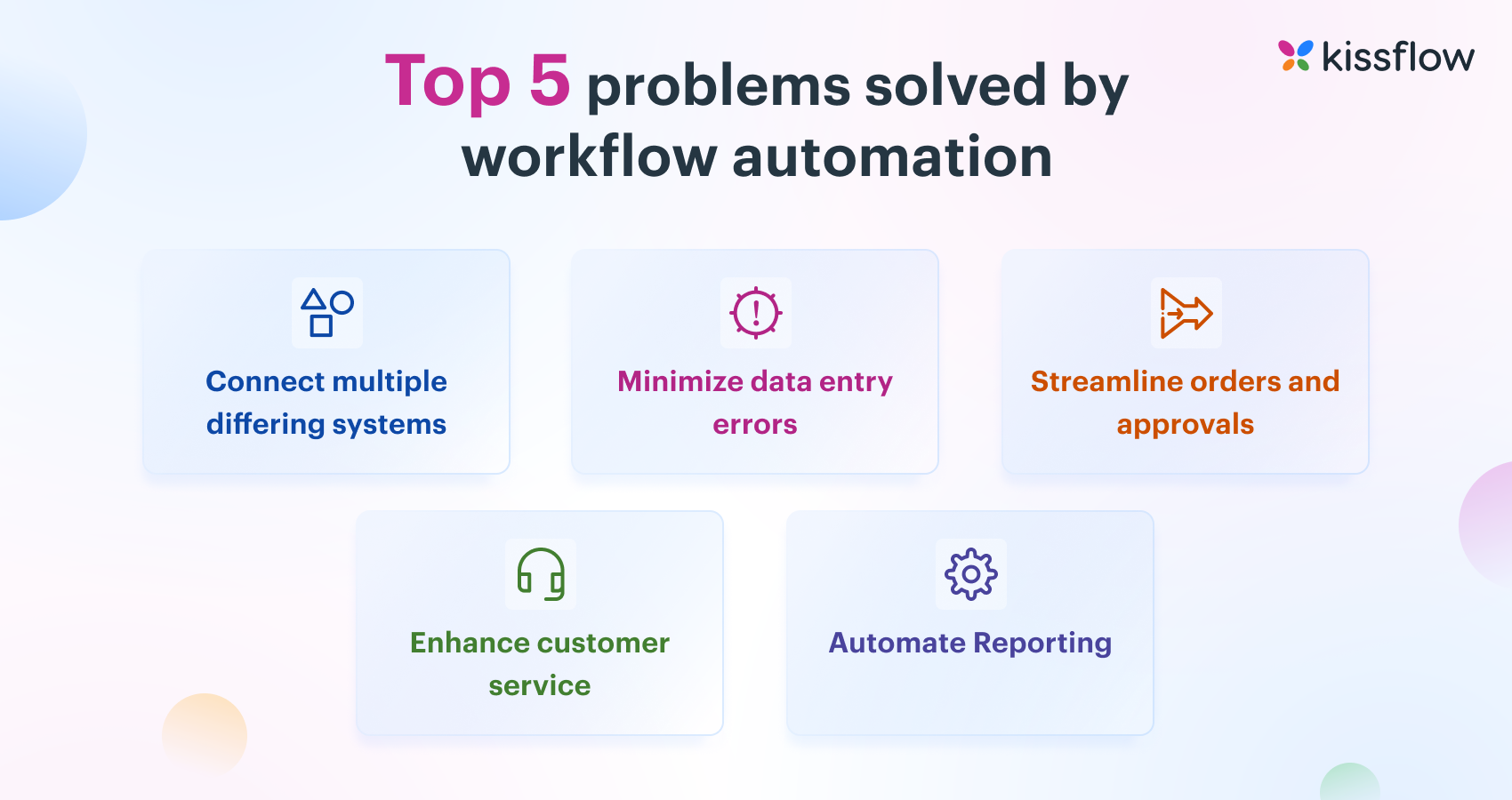
Here are the top 5 problems that workflow automation solves in an organization.
- Connect multiple differing systems
- Minimize data entry errors
- Streamline orders and approvals
- Enhance customer service
- Automate Reporting
50+ Crucial Workflow Automation Statistics for 2023
1. Automation Boosts Productivity
94% of small and medium-sized businesses (SMBs) perform repetitive, time-consuming tasks. Automation has improved jobs for 90% of knowledge workers and productivity for 66% of them.
2. It's Crucial for Digital Transformation
Automation and digitalization go hand in hand as these two combined, create new tech possibilities for your organization, better management of work, and streamline processes from start to end.
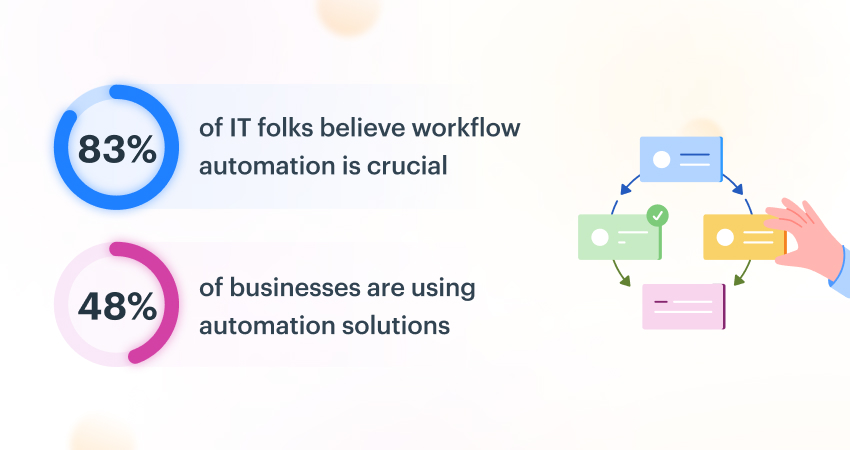
83% of IT leaders believe workflow automation is necessary for digital transformation. 48% of organizations are currently installing automation solutions to automate manual tasks.
3. Business Process Automation Is In High Demand

68% of employees have too much work to handle daily, which is why companies are adopting business process automation. If automation isn’t used to handle large volumes of work, these workers can reach a breaking point.
4. Effectively Handles Repetitive Tasks
36% of organizations are already using business process management software to automate workflows. 50% of business leaders plan to automate more repetitive tasks within their organizations.
5. Boosts Market Growth
By 2026, small and medium businesses will create market opportunities worth $1600 with workflow automation. The Industrial Automation Services Market is expected to grow from $147.06 Billion in 2019 to $264.69 Billion by 2026.
6. Puts Some Jobs at Risk
There’s a 14% increase yearly in the number of automated jobs and junior workers are the most affected. 69% of all managerial work will be automated by 2024. Automation is likely to affect more men than women. By 2023, 28% of currently employed men and 24% of women could lose their jobs. 38% of jobs in the US, 35% in Germany, 30% in the UK, and 21% in Japan may be affected.
7. Most Workers Aren’t Worried About Losing Their Jobs
73% of respondents in a PwC survey said they believe technology can never replace the human mind, while 37% were worried about automation putting their jobs at risk. Automation may force 40 to 160 million women to switch jobs.
8. Boosts the Customer Experience
A McKinsey survey showed respondents are 3 times likelier to have at least 80% of their customer interactions in digital form. 60% of customer service professionals give automated recommendations for the next best action. 37% of IT customer service departments have higher automation ROI than any other department.
9. Increases Efficiency
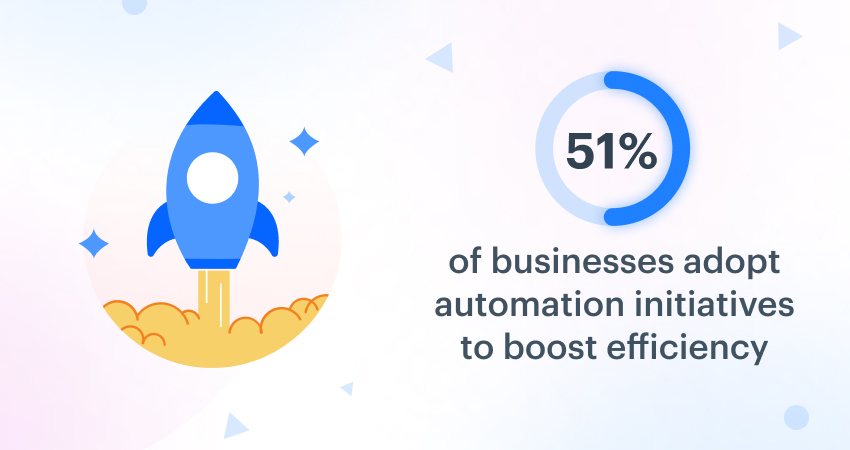
86% of employees believe automation will help them do their work more efficiently, while 65% believe technology will improve their future job prospects. 51% of businesses implement automation initiatives to boost efficiency.
10. Saves time
73% of IT leaders credit automation for helping employees save 10-50% of the time they previously spent on manual tasks. 85% of managers believe automating some tasks will give them and their employees extra time to focus on goals that matter to the company.
11. Automates Marketing
75% of organizations use marketing automation software. Scheduling social media posts is the most popular digital marketing element. 83% of marketers automate social media posting, 75% email marketing, 58% social media advertising, and 36% social media engagement.
12. It Motivates Employees to Upskill
Over 80% of managers are speeding up workflow automation and encouraging employees to work remotely. 74% of employees are ready to learn new skills or retrain to remain employable. They believe it’s their responsibility to upskill rather than rely on employers.
13. Most Companies Automate Several Business Functions
McKinsey surveyed in 2020 and discovered that 66% of businesses have automated business processes in more than one business function. In 2018, only 57% of businesses had automated several business functions.
14. Low-Code Automation Platforms Are Popular

24% of companies use low-code process automation systems, while 29% plan to start soon. These platforms help companies streamline workflows, make better use of their data, and save time and money.
15. There Are a Few Challenges
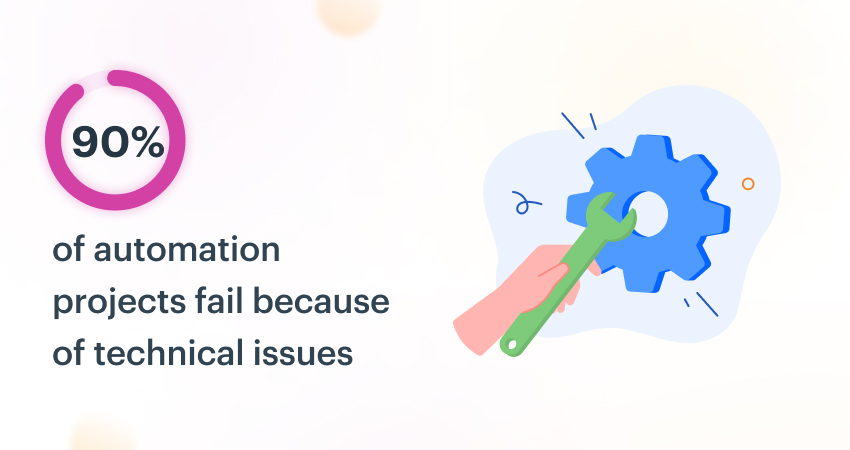
90% of automation projects fail because of technical issues, 37% because of implementation costs, and 25% because of no overall vision or strategy. The 3rd biggest challenge to implementing automation is resistance to change.
16. Automation Is Here to Stay
While up to 800 million jobs could be displaced by automation by 2030, automation will also offset the losses. It will spur economic growth, boost productivity, and minimize losses.
Trying to solve your hassles with workflow Automation?
Workflow automation for departments of all shapes and sizes
Human Resource
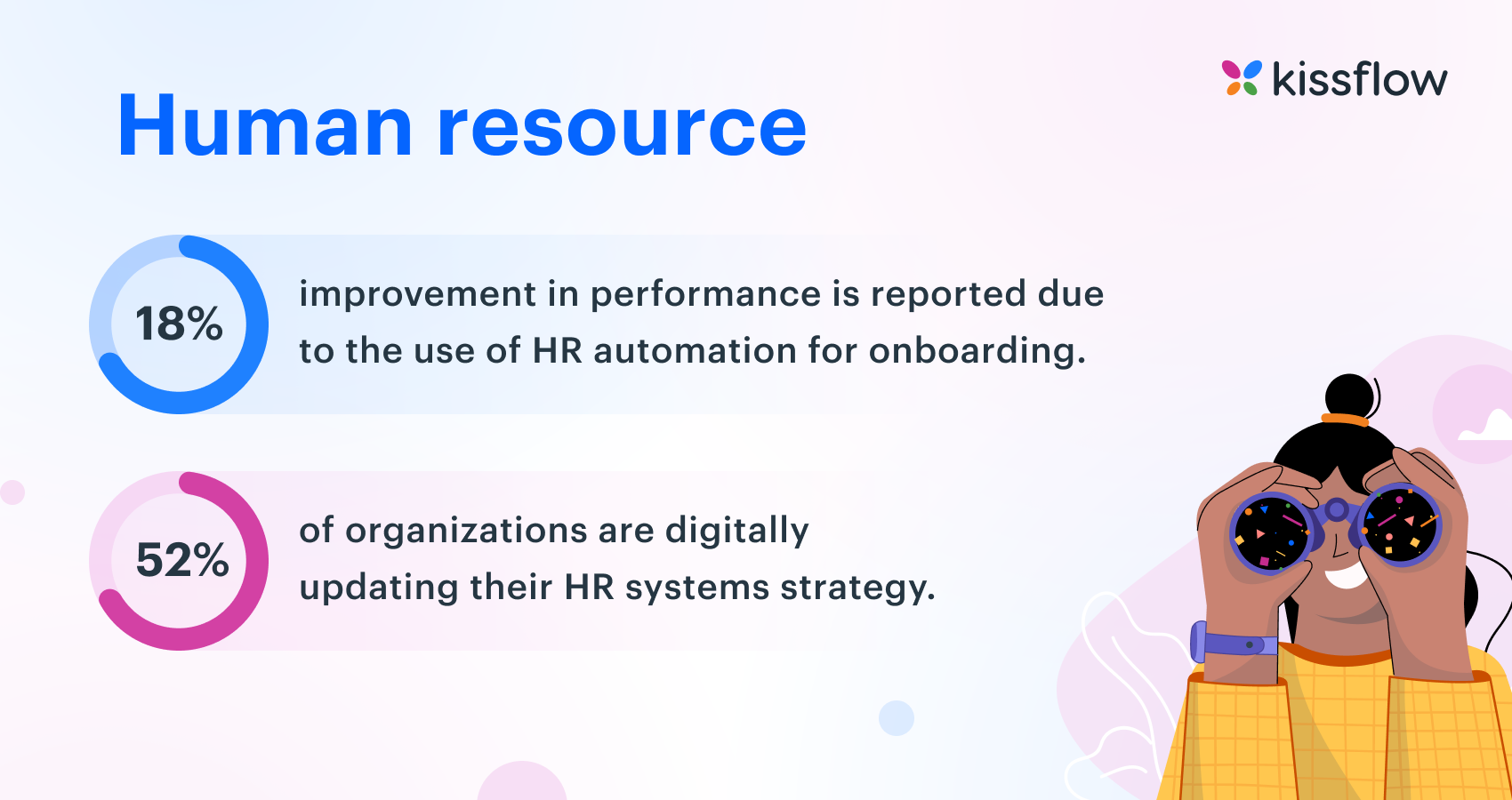
Right from hiring new talents, training, appraisal, meeting the local labor law, and an endless list of other tedious processes, HR management plays a vital role in every organization. Manually managing and processing a whole chunk of employees’ data is practically impossible. As the HR team holds the crux of the employee’s life cycle, automation is essential to manage these processes effectively.
- 25% of organizations report using HR automation, mainly for recruitment and hiring tasks.
- 69% of HR professionals that use automation in hiring stated that it drastically decreased the time spent on this process.
- 52% of organizations are digitally updating their HR systems strategy.
- 36% of HR professionals reported their onboarding processes are hindered due to a lack of onboarding automation.
- 18% improvement in performance is reported due to the use of HR automation for onboarding.
Finance
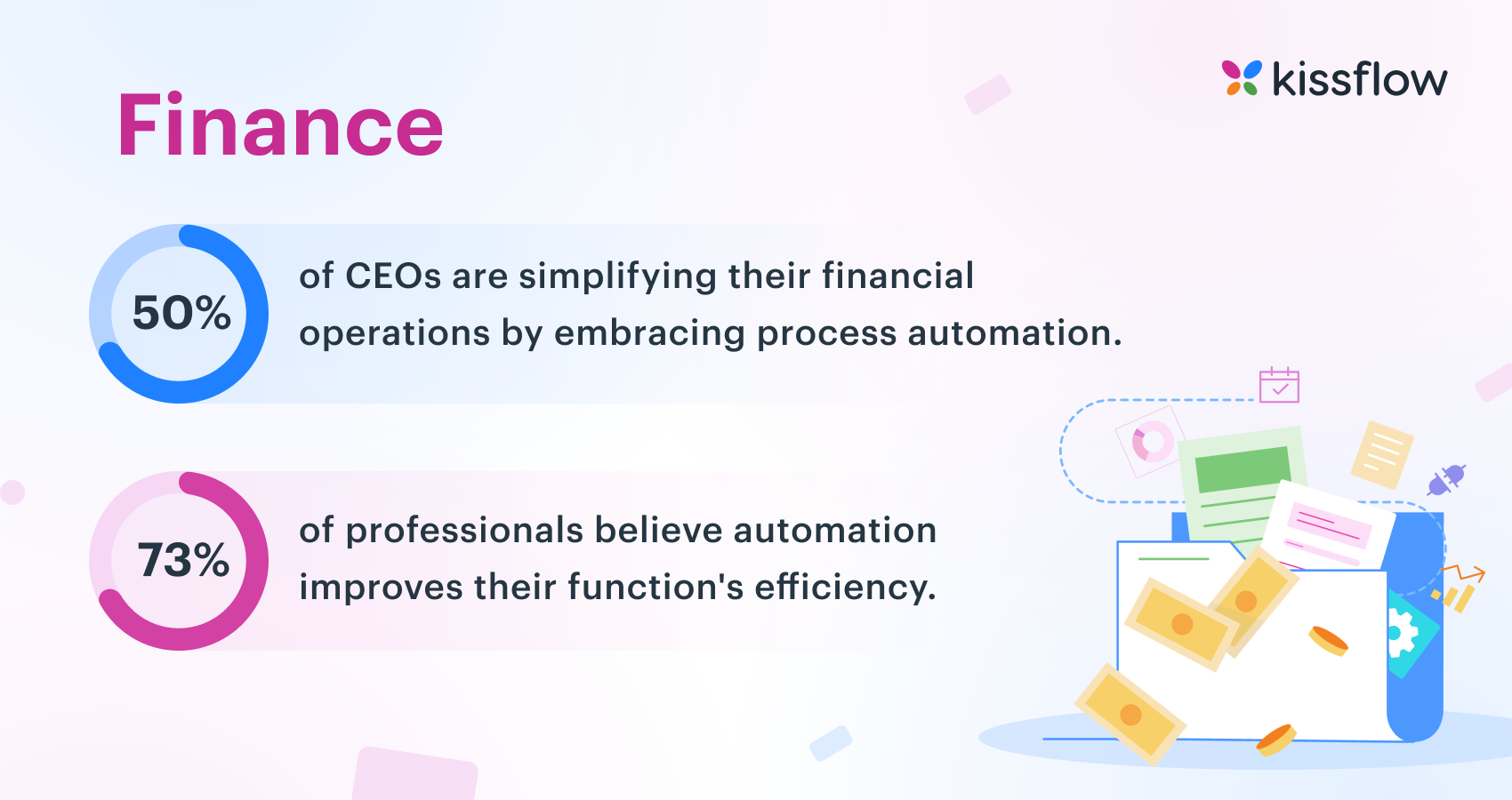
Financial and accounting processes are arguably the most excruciating as they involve numbers and cash flow. Managing the never-ending stream of data via Excel and mail can be an extra burden and stressful. By automating finance processes, organizations can eliminate clunky procedures, streamline accounting tasks, and ensure that everything runs as smoothly as possible.
- CEOs could save 20% of the time they spend on financial operations via automation.
- More than 50% of CEOs of banking and financial organizations are focusing on simplifying their operations by embracing process automation.
- Automation and AI are reported to take up 10-25% of banking tasks.
- 73% of finance professionals believe automation is improving their function’s efficiency and giving employees more time for critical tasks.
Information Technology

“Can IT processes even be automated?” is a frequently asked question among growing organizations. Not many IT processes can be automated. But there are a few mundane processes that can easily be streamlined to spare some time for IT professionals to focus on business-critical, strategic tasks.
- 40% of businesses’ automation initiatives are handled by the IT department.
- By 2023, 40% of enterprise workloads will be launched in the cloud.
- By 2024, 75% of businesses will have deployed multiple data hubs to drive business-critical data and analytics sharing and governance.
- 69% of daily managerial operations will be entirely automated by 2024.
Marketing and Sales
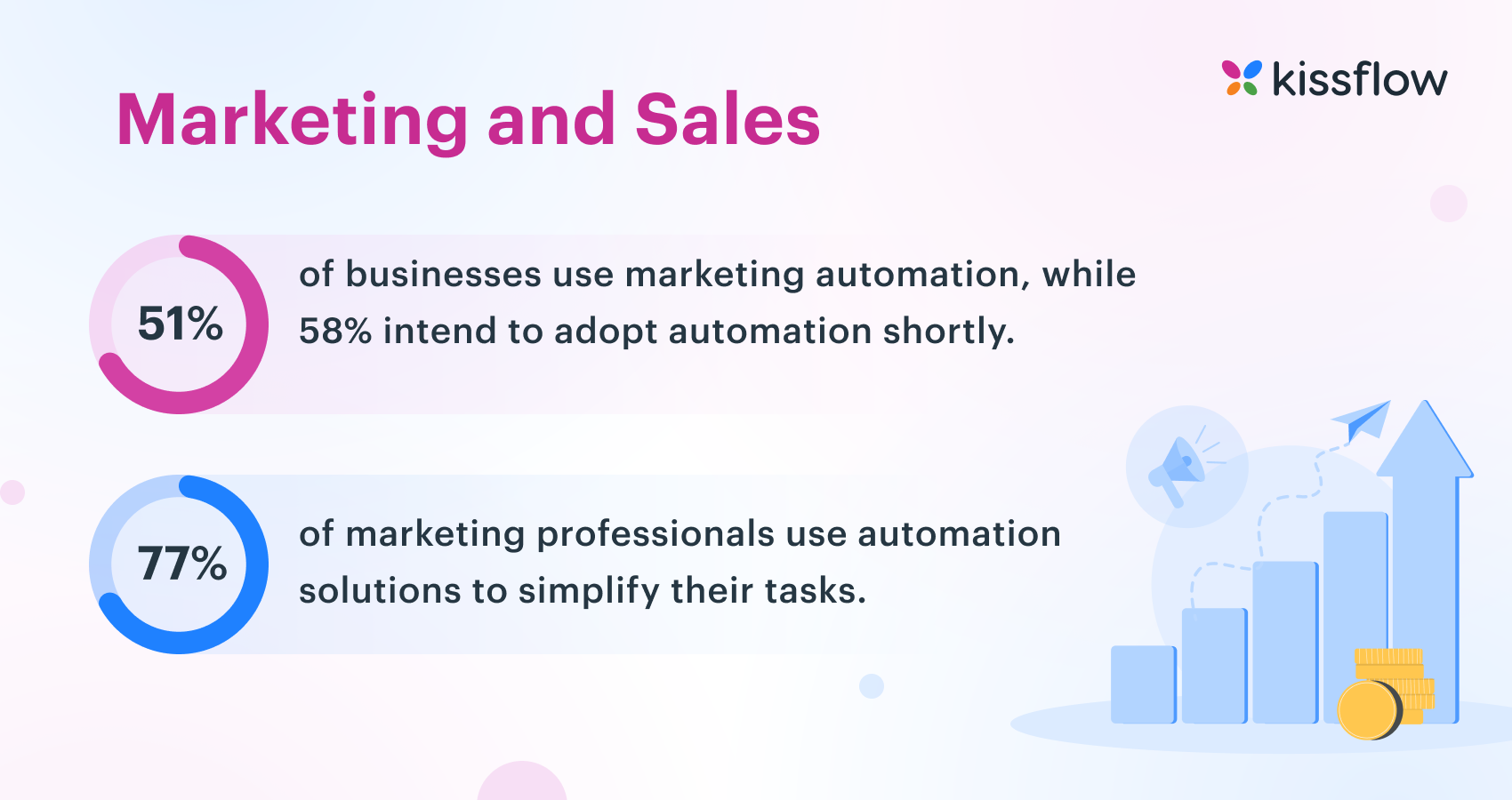
Your marketing and sales professionals’ time is too valuable to be spent on menial, time-consuming, non-productive tasks. By automating many steps between sales and marketing, your team can have time to look over the strategy and nurturing of leads. This in turn leads to more conversions and brand value.
- Automation has boosted productivity within the department by 14.5% and has brought down marketing spending by 12.2%.
- 77% of marketing professionals use automation solutions to simplify their tasks.
- 51% of businesses use marketing automation. 58% of B2B organizations intend to adopt automation technology in the near future.
- 83% of marketing departments automate social media post process, 75% automate email marketing tasks, 58% automate social media ads, and 36% automate social media management.
Trying to solve your hassles with workflow Automation?
The Future of Work and Business Will Be Defined By Workflow Automation
Every business can benefit from workflow automation. Research shows that 80% of organizations will adopt intelligent automation by 2025. This means that every company that wants to remain relevant and future-proof is automating its workflows. Some use low-code systems while others use no-code systems.
Workflow automation streamlines entire processes and assists a large number of companies to meet product demand, boosting efficiency, and implementing new business models. Automation is believed to enhance productivity in the long run, up to 2030, and it is likely to reduce the economic growth gap in the world’s 20 largest nations.
More than 80% of organizations already plan to increase their investment in automation solutions. To reap the full benefits of automation, get a robust work platform like Kissflow- an LCNC work platform that aligns business and IT together to transform and simplify your business processes.
Whether it is automating processes, digitizing your operations, managing requests, or building custom applications, with Kissflow you can do it all within a unified platform. By applying the low-code/no-code paradigm, Kissflow opens up development to everyone in the organization and dramatically accelerates digital transformation.
Start Your Workflow Automation With Kissflow
FAQs - Workflow Automation Stats
What percentage of companies use automation?
67% of companies currently use business process automation to streamline and automate their day-to-day repeatable tasks. 31% of companies have fully automated at least one of their major functions. 24% of companies have already implemented low-code process automation and another 29% are on the way to implementing it shortly.
How much time does workflow automation save?
73% of IT leaders are thankful to automation for helping employees save 10-50% of the time that they had previously spent on manual tasks. 85% of managers say that implementing automation, will give their team some extra time to focus on critical goals that matter to the business.
What percentage of manufacturing is automated?
More than 64% of global manufacturing activities can be automated, and the manufacturing industry will be the most impacted by automation, says a report by McKinsey.
Is RPA workflow automation?
Workflow automation focuses on automating a few specific tasks alone that constitute a business process or a workflow whereas RPA automates the complete workflows from beginning to end.
More Resources on Statistics
“Creating workflows is significantly easier here than in other products. We have been able to successfully distribute the work to create workflows because of Kissflow”
- Ryan H
Thanks for submitting.
Our solution experts will connect with you to get started.